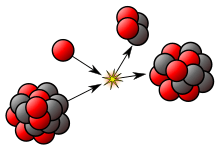Borromean nucleus
A Borromean nucleus is an atomic nucleus comprising three bound components in which any subsystem of two components is unbound.[1] This has the consequence that if one component is removed, the remaining two comprise an unbound resonance, so that the original nucleus is split into three parts.[2]
| Nuclear physics |
|---|
 |
| Nucleus · Nucleons (p, n) · Nuclear matter · Nuclear force · Nuclear structure · Nuclear reaction |
|
Models of the nucleus |
|
Nuclear stability |
|
Alpha α · Beta β (2β, β+) · K/L capture · Isomeric (Gamma γ · Internal conversion) · Spontaneous fission · Cluster decay · Neutron emission · Proton emission |
|
High-energy processes |
|
Nuclear fusion Processes: Stellar · Big Bang · Supernova Nuclides: Primordial · Cosmogenic · Artificial |
|
Scientists Alvarez · Becquerel · Bethe · A. Bohr · N. Bohr · Chadwick · Cockcroft · Ir. Curie · Fr. Curie · Pi. Curie · Skłodowska-Curie · Davisson · Fermi · Hahn · Jensen · Lawrence · Mayer · Meitner · Oliphant · Oppenheimer · Proca · Purcell · Rabi · Rutherford · Soddy · Strassmann · Świątecki · Szilárd · Teller · Thomson · Walton · Wigner |
The name is derived from the Borromean rings, a system of three linked rings in which no pair of rings is linked.[2]
Examples of Borromean nuclei
Many Borromean nuclei are light nuclei near the nuclear drip lines that have a nuclear halo and low nuclear binding energy. For example, the nuclei 6
He
, 11
Li
, and 22
C
each possess a two-neutron halo surrounding a core containing the remaining nucleons.[2][3] These are Borromean nuclei because the removal of either neutron from the halo will result in a resonance unbound to one-neutron emission, whereas the dineutron (the particles in the halo) is itself an unbound system.[1] Similarly, 17
Ne
is a Borromean nucleus with a two-proton halo; both the diproton and 16
F
are unbound.[4]
Additionally, 9
Be
is a Borromean nucleus comprising two alpha particles and a neutron;[3] the removal of any one component would produce one of the unbound resonances 5
He
, 5
Li
, or 8
Be
.
Several Borromean nuclei such as 9
Be
and the Hoyle state (an excited resonance in 12
C
) play an important role in nuclear astrophysics. Namely, these are three-body systems whose unbound components (formed from 4
He
) are intermediate steps in the triple-alpha process; this limits the rate of production of heavier elements, for three bodies must react nearly simultaneously.[3]
Borromean nuclei consisting of more than three components can also exist. These also lie along the drip lines; for instance, 8
He
is a five-body Borromean system with a four-neutron halo.[5] It is also possible that nuclides produced in the alpha process (such as 12
C
and 16
O
) may be clusters of alpha particles, having a similar structure to Borromean nuclei.[2]
As of 2012, the heaviest known Borromean nucleus is 29
F
.[6] Heavier species along the neutron drip line have since been observed; these and undiscovered heavier nuclei along the drip line are also likely to be Borromean nuclei with varying numbers (3, 5, 7, or more) of bodies.[5]
References
- Id Betan, R. M. (2017). "Cooper pairs in the Borromean nuclei 6He and 11Li using continuum single particle level density". Nuclear Physics A. 959: 147–148. arXiv:1701.08099. Bibcode:2017NuPhA.959..147I. doi:10.1016/j.nuclphysa.2017.01.004.
- Manton, N.; Mee, N. (2017). "Nuclear Physics". The Physical World: An Inspirational Tour of Fundamental Physics. Oxford University Press. pp. 387–389. doi:10.1093/oso/9780198795933.003.0012. ISBN 978-0-19-879611-4. LCCN 2017934959.
- Vaagen, J. S.; Gridnev, D. K.; Heiberg-Andersen, H.; et al. (2000). "Borromean Halo Nuclei" (PDF). Physica Scripta. T88 (1): 209–213. Bibcode:2000PhST...88..209V. doi:10.1238/Physica.Topical.088a00209.
- Oishi, T.; Hagino, K.; Sagawa, H. (2010). "Diproton correlation in the proton-rich Borromean nucleus 17Ne". Physical Review C. 82 (6): 066901–1–066901–6. arXiv:1007.0835. doi:10.1103/PhysRevC.82.069901.
- Riisager, K. (2013). "Halos and related structures". Physica Scripta. 2013 (14001): 014001. arXiv:1208.6415. Bibcode:2013PhST..152a4001R. doi:10.1088/0031-8949/2013/T152/014001.
- Gaudefroy, L.; Mittig, W.; Orr, N. A.; et al. (2012). "Direct Mass Measurements of 19B, 22C, 29F, 31Ne, 34Na and Other Light Exotic Nuclei". Physical Review Letters. 109 (20): 202503–1–202503–5. arXiv:1211.3235. doi:10.1103/PhysRevLett.109.202503. PMID 23215476.